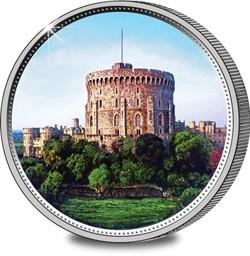-no-button.jpg)
 |
Location: Windsor, Berkshire, England
Date completed: 11th Century (subsequently
extensively rebuilt and modified)
Designer/Builder: Originally commissioned by
William the Conqueror, frequent rebuilt by succeeding
monarchs.
Function: Stronghold and royal residence
|
Even today, Windsor Castle dominates the skyline - you can see
it clearly from the motorway and, on a clear day, even from the top
of the London Eye, 25 miles (40 km) away. That was what it was
meant to do when it was originally built after the Norman Conquest,
occupying a strategic position overlooking the River Thames and
routes out of London. Originally a wood and earth motte and bailey
structure, Windsor Castle has been strengthened, enlarged and
refurbished ever since. Henry I (reigned 1100-1135) used it as a
residence, as did successive monarchs, making it the longest
continuously occupied palace in Europe. Henry III (r. 1216-1272)
remodelled the state apartments within its walls and added five
circular towers, while Edward III (r. 1327-1377) comprehensively
rebuilt the Castle, adding the College of St George, new Royal
apartments, the Great Hall and the Royal Chapel. The
Parliamentarians occupied the Castle during the Civil War and used
it as a prison. Charles I was buried in the Chapel of St George
after he was executed in 1649. After the Restoration, Charles II
(r. 1660-1685) made the Castle a royal residence again,
commissioning a range of elaborate Baroque interiors. George III
(r. 1760-1820) and George IV (r. 1820-30) rebuilt the Castle at
huge expense producing the State Apartments much as we see them
today. During World War II (1939-1945) the royal Princesses
Elizabeth and Margaret lived full time at Windsor Castle as a
refuge from the Blitz. It is today the preferred weekend home of
Queen Elizabeth II.
On the morning of Friday 20th November 1992 a fire started in
Windsor Castle, when a spotlight ignited a curtain in the Queen's
Private Chapel. Despite the rapid response of the in-house and
local fire fighters (eventually numbering several hundred) the fire
spread rapidly and caused extensive damage to the fabric of the
Castle. Fortunately no one was killed or seriously injured and
volunteers managed to save much valuable art works and furniture
(including a 150 ft (46 m) long table!). However, it took several
years to repair the damage, at a cost of £36.5 million.